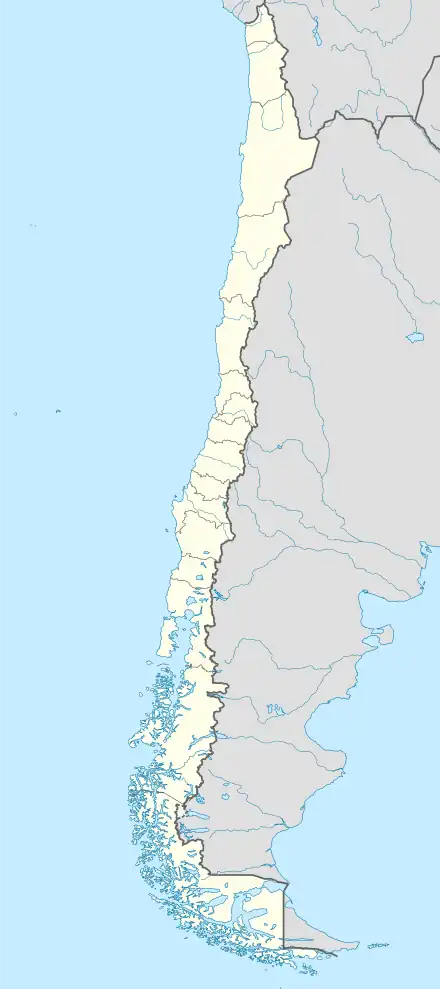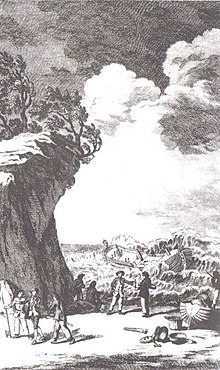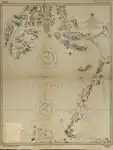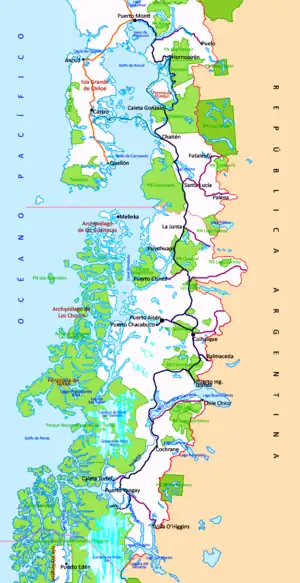Wager Island
Wager Island (Spanish: Isla Wager) is an uninhabited island in Guayaneco Archipelago, a remote part of western Patagonia. Located 1,600 kilometres (990 miles) south of Santiago, the island is part of Capitán Prat Province of the Aysén Region, Chile. The island was the location of the Wager Mutiny, which took place in October 1741 after the wreck of the British warship HMS Wager.[2]
 Map of Chilean Patagonia (latitudes 47°S to 49°S). Wager Island forms the northwestern terminus of the Messier Channel, while the Larenas Peninsula forms the northeastern terminus. | |
 | |
 Wager Island Location of Wager Island in Chile | |
| Geography | |
|---|---|
| Location | Capitán Prat Province, Aysén Region, Chile |
| Coordinates | 47°43′27″S 74°57′37″W |
| Archipelago | Guayaneco Archipelago |
| Area | 105 km2 (41 sq mi) |
| Highest elevation | 586 m (1923 ft) |
| Highest point | Monte Wager[1] |
| Administration | |
History
Early history
The Guayaneco Archipelago is thought to have been a cohabitational contact zone between different canoe-faring indigenous peoples living north and south of it. Anthropologist John Montgomery Cooper points out that it possibly made up a "meeting ground of quasi-friendly bilingual tribes".[3]
European explorers began to map this area after the discovery of the Strait of Magellan in 1520. Members of the 1553 naval expedition of Francisco de Ulloa were the first Europeans to encounter the Chono people.[4] The islands were first reached by Jesuits based in Chiloé in 1613.[5] False rumors of European settlements near the Straits of Magellan prompted the Spanish to send an expedition led by Bartolomé Gallardo in 1674–1675, and later the Antonio de Vea expedition of 1675–1676.[6][7]
Northern tribes such as the Chonos, Huilliche and the Spanish of Chiloé called in colonial times the sea-faring people of the area of Wager Island "Caucahue".[8] They spoke a language different from Chono and according to historian Ximena Urbina and co-workers the Caucahue are essentially ancient Kawésqar.[9]
Wreck of HMS Wager

On 18 September 1740, the British warship HMS Wager (a part of Commodore George Anson's squadron) departed St Helens with a ship's crew of 160 men[10] along with a large number of invalids and marines.[11] After becoming embayed in the Gulf of Penas just south of the Taitao Peninsula, Wager ran aground at what would become known as Wager Island on 14 May 1741.[12][13] Initially, about 140 men survived, making it to the island in ship's boats.[14] By the end of June, many of these men had died on the island from starvation, drowning, hypothermia and trauma.[15]
After many arduous months, two groups of castaways eventually departed Wager Island. The first group, consisting of 81 mutineers,[16] departed Wager Island on 13 October 1741.[17][18] Of this group, 30 men[19] arrived in Río Grande, Brazil, on 28 January 1742.[20] One of these men died shortly after arriving at Río Grande.[21]
A second group of men (11 castaways and one Indian guide) departed Wager Island on 6 March 1742.[22] Guided by the Chono cheftain Martín Olleta,[23] the group navigated through Presidente Ríos Lake in the interior of Taitao Peninsula instead of rounding to the west of the treacherous Tres Montes Peninsula.[24][25] Of this group, three survivors (Captain David Cheap, midshipman John Byron, and midshipman Alexander Campbell) arrived in Chiloé Island, Chile,[26][27] in early June 1742.[28] One final survivor (Marine Lieutenant Thomas Hamilton) was rescued and brought to Chiloé Island by a Spanish search party about three months later.[26] Altogether, only 36 men returned alive to Britain, according to The Wager Disaster (2015) by Rear Admiral C. H. Layman.[29][15]
Fate of the wreck of HMS Wager
From late 1742 to 1769, the Spanish and the local indigenous people conducted multiple salvage expeditions on the wreck of HMS Wager. A Jesuit priest named Pedro Flores conducted a small salvage operation in late 1742, in which he recovered nearly 100 kg (220 lb) of iron.[30] The first large-scale salvage effort was the expedition of Mateo Abraham Evrard, which took place in 1743. Among the items recovered from this operation were ten iron six-pound cannons, four bronze three-pound cannons, an anchor, more than 100 cannonballs and 1000 musket balls, and three copper cauldrons.[31]
In 1779, Spanish missionaries Fray Benito Marín and Fray Julián Real found an indigenous settlement consisting of four dwellings that had been constructed on the beach close to the site of the wreck.[32]
The Scientific Exploration Society mounted an expedition in 2006 to attempt to locate what was left of the wreck. The team found, in shallow water, a 5 square metres (54 square feet) piece of wooden hull planking that appeared to be consistent with the construction of Wager.[33]
Geography

Wager Island is located in the Guayaneco Archipelago, 1,600 kilometres (990 miles) south of Santiago, in the southern part of the Gulf of Penas of the southern Pacific Ocean. It is 18 kilometres (11 miles) long on its NW-SE axis and 10 kilometres (6.2 miles) wide. Of the two main islands that make up the Guayaneco Archipelago, Byron Island is the larger, and Wager Island is the smaller. It is separated from Byron Island by Paso Rundle,[34] and separated from Islote San Pedro by Bahía Acosta.[35] Wager Island and Islote San Pedro form the northwestern terminus of the Messier Channel, while the Larenas Peninsula forms the northeastern terminus.[36] There is a lighthouse (NGA 2044) on Islote San Pedro. The Messier Channel is regularly traversed by large cargo ships and cruiseferries.[38]
Because the island is located between 46° and 60° south of the equator, it is classified as a subantarctic island. During the Llanquihue glaciation, advancing glaciers caused the forests to retreat far to the north. The region was gradually reforested starting about 10,000 years ago as the climate warmed and the glaciers retreated. Deglaciation was almost complete around 14,000 years ago.[39] Today, Wager Island consists of a series of highlands and ravines and has many steep headlands and promontories. Notable peaks include Monte Anson, with its summit at 377 metres (1,237 feet),[40] and Monte Wager, with its summit at 586 metres (1,923 feet).[1] The lower slopes of these mountains are covered with Magellanic subpolar forests.[41]
The nearest settlement is the village of Caleta Tortel, which is situated 107 kilometres (66 miles) to the east, while the nearest airport is Caleta Tortel Airport. Apart from Caleta Tortel, the next closest settlement is the village of Villa Puerto Edén, 165 kilometres (103 miles) to the south. Villa Puerto Edén is among the most remote villages of southern Chile.[42]
Geology
Wager Island is one of a series of islands and deep bays that are the remnants of a now-submerged coastal range.[41] The island is of igneous origin, and dates from the tertiary period. It is the product of the same geological phenomenon that caused the development of the Chilean Coast Range and the Andes.[43] Passing through Paso Suroeste—off the southern coast of Wager Island—[44] is the Liquiñe-Ofqui Fault system, a major geological fault that exhibits current seismicity.[45][46]
Three tectonic plates (the Antarctica, South America and Nazca) meet at the Chile Triple Junction (CTJ), near the Taitao Peninsula. The Nazca and Antarctic plates are moving to the east, while the South American plate is moving to the west. This situation has resulted in the subsidence of the western edge of the South American plate, lowering it to its current level and resulting in the large number of islands that exists today at that location. Subduction of the Chile Ridge beneath the South American plate at the CTJ has caused a sequence of three ridge–continent collisions, starting about 5 million years ago.[43]
During the Llanquihue glaciation, the Guayaneco Archipelago was covered with glaciers, which carved deep valleys into the islands. Today these glacial troughs are deep channels (such as the Messier Channel and the Fallos Channel) and fjords.[41]
Flora and fauna
Wager Island falls within the terrestrial ecoregion known as the Magellanic subpolar forests. This is a temperate broadleaf and mixed forests ecoregion within the neotropical realm.[47] Due to its climate and recent glaciation, biodiversity on the island is somewhat limited.[48] Environmental conditions on the island are characterized by cool temperatures, high rainfall, strong subpolar winds, and rocky ground with generally thin soil and poor drainage. Accordingly, most of the terrain is Magellanic moorland, peatlands and bogs consisting of mosses, grasses, cushion plants, and dwarf shrubs.[49] Depending on which criteria are used, Magellanic moorland may be classified as either tundra or heathland.[50]
Gallery
See also
References
- "Monte Wager". GeoNames geographical database. Wollerau, Switzerland. 2023. Retrieved 24 April 2023.
- Layman 2015, pp. 82–90.
- Cooper 1917, p. 40.
- Trivero Rivera 2005, p. 44.
- Sepúlveda Ortíz, Jorge (2003). "Exploraciones efectuadas en la región de Trapananda antes del siglo XIX" [Explorations carried out in the Trapananda region before the 19th century] (PDF). Boletín de la Academia de Historia Naval y Marítima de Chile (in Spanish). 7: 95–110.
- Martinic B., Mateo; Moore, David M. (1982). "Las exploraciones inglesas en el estrecho de Magallanes. El mapa manuscrito de John Narborough" [English explorations in the Strait of Magellan. John Narborough's manuscript map] (PDF). Anales del Instituto de la Patagonia (in Spanish). 13: 7–20.
- Urbina Carrasco, María Ximena (2016). "Interacciones entre españoles de Chiloé y Chonos en los siglos XVII y XVIII: Pedro y Francisco Delco, Ignacio y Cristóbal Talcapillán y Martín Olleta" [Interactions between Spaniards of Chiloé and Chonos in the XVII and XVII centuries: Pedro and Francisco Delco, Ignacio and Cristóbal Talcapillán and Martín Olleta] (PDF). Chungara (in Spanish). 48 (1): 103–114.
- Alvarez Abel, Ricardo (2002). "Reflexiones en torno a las identidades de las poblaciones canoeras, situadas entre los 44º y 48º de latitud sur, denominadas "chonos"". Anales del Instituto de la Patagonia, serie Ciencias Humanas (in Spanish). 30: 79–86.
- Urbina Carrasco, María Ximena; Reyes, Omar; Belmar, Carolina A. (2020). "Canoeros en Chiloé: de facilitadores de las navegaciones españolas en los archipiélagos los Chonos y de Guayaneco, a productores y comerciantes, 1567-1792" [Coastal hunter-gatherers in Chiloé: From facilitators of the navigation of Spaniards in the Chonos and Guayaneco archipelagoes to producers and traders, 1567-1792]. Chungara (in Spanish). 52 (2). doi:10.4067/S0717-73562020005000702. S2CID 216352223.
- Pack 1960, p. 18.
- Anson 1748, p. 14.
- Bulkeley & Cummins 1743, pp. 17–19.
- Layman 2015, pp. 42–59.
- Layman 2015, p. 42, 58.
- Dalya Alberge (29 January 2015). "Previously unpublished letter casts new light on mutiny aboard HMS Wager". The Guardian. London. Retrieved 22 April 2023.
- Layman 2015, pp. 89–90.
- Layman 2015, pp. 87–89.
- Bulkeley 1743, pp. 101–105.
- Layman 2015, p. 115.
- Layman 2015, p. 113.
- Layman 2015, p. 114.
- Pack 1960, p. 46.
- Byron 1768, p. 106.
- Vásquez Caballero, Ricardo Felipe (2008). "Aau, el secreto de los chono" (PDF) (in Spanish). Retrieved 24 January 2019.
{{cite journal}}: Cite journal requires|journal=(help) - Urbina Carrasco, María Ximena (2010). "La navegación por los canales australes en la Patagonia Occidental insular en los siglos coloniales: La ruta del istmo de Ofqui" [Navigation through the southern channels in the insular Western Patagonia in the colonial centuries: The route of the isthmus of Ofqui]. Magallania (in Spanish). 38 (2): 41–67. doi:10.4067/S0718-22442010000200003.
- Layman 2015, p. 205.
- Byron 1768, pp. 175–177.
- Grann 2023, p. Map: First Castaway Party's Escape Route.
- Layman 2015, p. 11, Foreword by Philip, Duke of Edinburgh:"Only 36 of the original crew of about 140 made it back to Britain..."
- Layman 2015, p. 273.
- Layman 2015, pp. 273–275.
- Layman 2015, p. 279.
- Layman 2015, pp. 301–309.
- "Paso Rundle". GeoNames geographical database. Wollerau, Switzerland. 2023. Retrieved 24 April 2023.
- "Bahía Acosta". GeoNames geographical database. Wollerau, Switzerland. 2023. Retrieved 24 April 2023.
- Larenas Peninsula in Geonames.org (cc-by)
- "Quiénes somos" [Who We Are] (in Spanish). Armasur. Retrieved 22 April 2023.
- Lowell, T.V.; Heusser, C.J.; Andersen, B.J.; Moreno, P.I.; Hauser, A.; Heusser, L.E.; Schlüchter, C.; Marchant, D.R.; Denton, G.H. (1995). "Interhemispheric Correlation of Late Pleistocene Glacial Events". Science. 269 (5230): 1541–1549. Bibcode:1995Sci...269.1541L. doi:10.1126/science.269.5230.1541. PMID 17789444. S2CID 13594891.
- Monte Anson in Geonames.org (cc-by)
- "Photo # STS091-729-004: Guayaneco Archipelago, Chile". Johnson Space Center Earth Science and Remote Sensing Unit. Earth from Space - Image Information. Houston, Texas: NASA. 7 June 1998. Retrieved 22 April 2023.
- Andria Hautamaki (3 August 2020). "A Visit to 5 of Patagonia's Most Remote Schoolhouses". The New York Times. New York. Retrieved 28 April 2023.
- Nelson, Eric; Forsythe, Randall; Diemer, John; Allen, Mike; Urbina, Octavio (1993). "Taitao ophiolite: a ridge collision ophiolite in the forearc of southern Chile (46°S)". Revista Geológica de Chile. 20 (2): 137–165.
- Paso Suroeste in Geonames.org (cc-by)
- Lange, D.; Cembrano, J.; Rietbrock, A.; Haberland, C.; Dahm, T.; Bataille, K (2008). "First seismic record for intra-arc strike-slip tectonics along the Liquiñe-Ofqui fault zone at the obliquely convergent plate margin of the southern Andes". Tectonophysics. 455 (1–4): 14. Bibcode:2008Tectp.455...14L. doi:10.1016/j.tecto.2008.04.014.
- Pérez-Flores, Pamela; Cembrano, José; Sánchez-Alfaro, Pablo; Veloso, Eugenio; Arancibia, Gloria; Roquer, Tomás (2016). "Tectonics, magmatism and paleo-fluid distribution in a strike-slip setting: Insights from the northern termination of the Liquiñe–Ofqui fault System, Chile" (PDF). Tectonophysics. 680: 192–210. Bibcode:2016Tectp.680..192P. doi:10.1016/j.tecto.2016.05.016.
- Hogan, C. Michael; World Wildlife Fund (14 May 2014). Draggan, Sydney (ed.). "Magellanic subpolar forests". Encyclopedia of Earth. Washington DC: National Council for Science and the Environment. Retrieved 22 April 2023.
- Villagrán, Carolina; León, Ana; Roig, Fidel A. (2004). "Paleodistribución del alerce y ciprés de las Guaitecas durante períodos interestadiales de la Glaciación Llanquihue: provincias de Llanquihue y Chiloé, Región de Los Lagos, Chile" [Paleodistribution of larch and Guaitecas cypress during interstadial periods of the Llanquihue Glaciation: Llanquihue and Chiloé provinces, Los Lagos Region, Chile]. Revista Geológica de Chile (in Spanish). 31 (1): 133–151. doi:10.4067/S0716-02082004000100008.
- Fraser, L.H. Fraser and P.A. Keddy (eds.). 2005. The World's Largest Wetlands: Ecology and Conservation. Cambridge University Press, Cambridge, UK.
- Longton 1988, pp. 13–22.
Bibliography
- Anson, George (1748). Walter, Richard (ed.). A Voyage Round the World in the years MDCCXL, I, II, III, IV. London: John & Paul Knapton.
- Bulkeley, John; Cummins, John (1743). A voyage to the South-Seas, in the years 1740-1. London: Jacob Robinson.
- Byron, John (1768). The narrative of the Honourable John Byron. London: S. Baker & G. Leigh.
- Cooper, John M. (1917). Analytical and Critical Bibliography of the Tribes of Tierra Del Fuego and Adjacent Territory. Bulletin 63. Washington, DC: Bureau of American Ethnology, Smithsonian Institution.
- Grann, David (2023). The Wager: A Tale of Shipwreck, Mutiny and Murder. New York: Doubleday. ISBN 978-0385534277.
- Layman, C. H. (2015). The Wager disaster: mayhem, mutiny and murder in the south seas. London: Uniform Press. ISBN 978-1910065501.
- Longton, R.E. (1988). Biology of Polar Bryophytes and Lichens. Studies in Polar Research. Vol. 1. Cambridge, England: Cambridge University Press. ISBN 0521250153.</ref>
- Pack, S. W. C. (1960). Admiral Lord Anson: the story of Anson's voyage and naval events of his day. London: Cassell & Company.
- Pack, S. W. C. (1964). The Wager Mutiny. London: Alvin Redman.
- Paine, Ralph Delahaye (1921). Lost Ships and Lonely Seas. New York: The Century Company.
- Trivero Rivera, Alberto (2005). Los primeros pobladores de Chiloé: Génesis del horizonte mapuche [The first settlers of Chiloé: Genesis of the Mapuche horizon] (PDF) (in Spanish). Uppsala: Ñuke Mapuförlaget. ISBN 91-89629-28-0.








.png.webp)